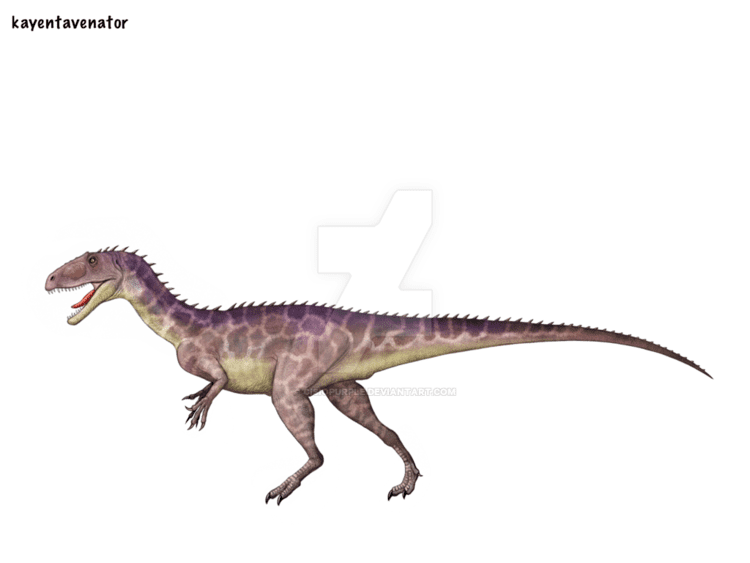Rank Species | Class Reptilia Phylum Chordata | |
 | ||
Genus †KayentavenatorGay, 2010 Similar Colepiocephale, Sarahsaurus, Duriavenator, Alaskacephale, Gravitholus | ||
Kayentavenator (meaning "Kayenta hunter") is a small carnivorous dinosaur genus which lived during the Early Jurassic Period; fossils were recovered from the Kayenta Formation of northeastern Arizona and were described in 2010.
Contents
Description
The holotype specimen of K. elysiae is a juvenile, as shown by unfused neural spines and would have stood about 0.5 metres (1.6 ft) high at the hip. The adult size of Kayentavenator is unknown. The inclusion of a pubic fenestra is one of the characteristics that Gay uses to set Kayentavenator apart from the contemporaneous, and better known Dilophosaurus. As Dilophosaurus lacks a pubic fenestra as a subadult or an adult, it is unlikely that it had one during any stage of ontogeny. Apomorphies include an ellipsoid acetabulum, the greater trochanter and the head of the femur having been fused, a mediodistal crest that extends 50% of the length of the femur, as well as a prominent accessory condyle on the medial femoral condyle, a groove in dorsal surface of the femoral head that extends out from the centerline of the body, and highly constricted ("waisted") caudal vertebra centra.
Discovery
The only known fossils of Kayentavenator were excavated by the University of California Museum of Paleontology from the Navajo Reservation in Arizona. It was described in 2010 based on a partial fossil skeleton, consisting of part of the pelvis, partial hindlimbs, and vertebrae.
Relationships
Timothy Rowe originally assigned the holotype specimen of Kayentavenator to the coelophysoid Syntarsus kayentakatae. It is unlikely that Kayentavenator is actually cogeneric with Megapnosaurus due to the number of tetanuran characters that Kayentavenator possesses and M. kayentakatae lacks, such as the pubic fenestra and a sharp ridge on the medial side of the tibia. A cladistic analysis of the remains showed Kayentavenator to lie outside of Coelophysidae, and was closer to Allosaurus. This would make Kayentavenator the oldest known tetanuran from North America. The fragmentary remains of Kayentavenator make this open to further interpretation.
Habitat
The only known specimen of Kayentavenator, UCMP V128659, was recovered from the Silty Facies Member of the Kayenta Formation, in northeastern Arizona. A definitive radiometric dating of this formation has not yet been made, and the available stratigraphic correlation has been based on a combination of radiometric dates from vertebrate fossils, magnetostratigraphy and pollen evidence. It has been surmised that the Kayenta Formation was deposited during the Sinemurian and Pliensbachian stages of the Early Jurassic Period or approximately 199 to 182 million years ago. The Kayenta Formation is part of the Glen Canyon Group that includes formations not only in northern Arizona but also parts of southeastern Utah, western Colorado, and northwestern New Mexico. The formation was primarily deposited by rivers. During the Early Jurassic period, the land that is now the Kayenta Formation experienced rainy summers and dry winters. By the Middle Jurassic period it was being encroached upon from the north by a sandy dune field that would become the Navajo Sandstone. The animals were adapted to a seasonal climate and abundant water could be found in streams, ponds and lakes.
Paleofauna
Kayentavenator shared its paleoenvironment with other dinosaurs, such as several theropods including Dilophosaurus, Megapnosaurus kayentakatae, the "Shake N Bake" theropod, the basal sauropodomorph Sarahsaurus,heterodontosaurids, and the armored dinosaurs Scelidosaurus and Scutellosaurus. The Kayenta Formation has produced that remains of three coelophysoid taxa of different body size,which represents the most diverse ceratosaur fauna yet known. The Kayenta Formation has yielded a small but growing assemblage of organisms. Vertebrates present in the Kayenta Formation at the time of Kayentavenator included hybodont sharks, bony fish known as osteichthyes, lungfish, salamanders, the frog Prosalirus, the caecilian Eocaecilia, the turtle Kayentachelys, a sphenodontian reptile, various lizards. Also present were, the synapsids Dinnebiton, Kayentatherium, and Oligokyphus., several early crocodylomorphs including Calsoyasuchus, Eopneumatosuchus, Kayentasuchus, and Protosuchus, and the pterosaur Rhamphinion. The possible presence of the early true mammal Dinnetherium, and a haramyid mammal has also been proposed, based on fossil finds.
Vertebrate trace fossils from this area included coprolites and the tracks of therapsids, lizard-like animals, and dinosaurs, which provided evidence that these animals were also present. Non-vertebrates in this ecosystem included microbial or "algal" limestone, freshwater bivalves, freshwater mussels and snails, and ostracods. The plant life known from this area included trees that became preserved as petrified wood.
